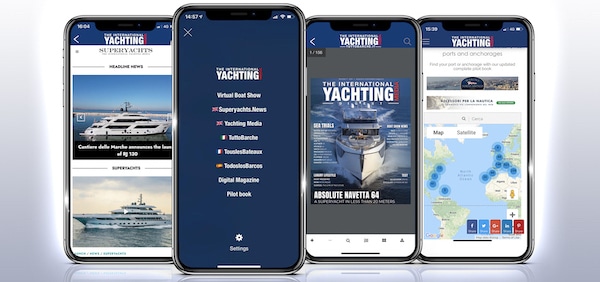Massimo Picco isn’t 44 yet but he has been designing yachts for almost a quarter century. He founded his Picco Yacht Design (PYD) studio in Verona in 1994 and, since then, he has been designing sailing and motor boats ranging from 20 to 120 feet, even if he often enjoys to wander off the point.
Like, for example, when he designs luxury villas (including those provided with private boats) kitchens or handles. Nonconformist, intransigent and passionate, Picco loves anything extreme and non-trivial in both boats and cars, another among his great passions which has recently driven him to establish a collaboration with the vintage car department of a prestigious Italian automobile manufacturing brand. Aesthetics and performances are the leading concepts of PYD studio. Today, after some years dedicated more to cars than boats, Picco has come back to recreational yachting. And while he is about to launch a new series of open motorboats that we’ll present in the next few weeks, we asked him to tell his vision of the world of boating.

You have professionally gone through the last five years, marked by some important technological and design innovations. Well, what was the main change brought to the sailing experience in this period?
Generally speaking, I’d say that the deck has suffered a radical change, starting from the cockpit, for example. In the past, it was just a “hole” offering some shelter to the helmsman. Today, it represents the entire boat. On the other hand, I was particularly impressed by the opposite efforts to hold back development, combining modern design with inadequate technologies.

Can you give us some examples?
Today, the market offers many boats featuring the same shapes than advanced prototypes. However, they are still built with traditional materials, such as heavy and infusion-laminated resins. The same goes for sail plans. Carbon masts are rigid and light, they ensure great performances but, after a first boom period, boat manufacturers are starting to abandon them.

Does it also apply to standard boats?
Yes, of course. Many standard boats could be equipped with carbon masts. A good aluminium mast for a 40-footer costs about 25 thousand euros. A cheap but high-quality aluminium one costs only 6,000 euros more. We can continue to adopt aluminium and reinforcing steel for cross-trees and shrouds respectively, we don’t need exotic fibres; however, the boat would benefit from many advantages, starting from a significantly lighter weight.
So, don’t you like the current market?
Today, many boats are silly: they don’t move with little air and they get broken under strong wind. Boat manufactures seem to pursue appearance and not quality. Elements are put together only because they seem cool even if they don’t work, like putting a sail plan with a square-top mainsail and a non-overlapping jib on a classic hull. The market offers boats which aren’t so fast as they look. Some of them have stern large as an Imoca 60 but their engine room houses just a 55 HP engine instead of a 90 HP one: volumes are not properly used since there’s no enough power to push them. Consumption is greater and safe is lower in rough sea. A stylish but bulky boat is inevitably slower since it sails with wrong geometries.


Are sail plans adequate?
Bah, also in this case, there’s still much to be done. What’s the point of installing a 40 cm bowsprit on a gennaker if a Code 0 furler ensures the same performances with half of the maneuvers?
So, is it a bad time?
I’d say a hybrid moment. Shapes exist but lack materials. We see very fast boats (like, for example, Volvo and Imoca sailing yachts for ocean races) but we settle for cheaper and less performing ones. Not to mention interiors and wood quality… furniture is entirely bought at Ikea.

Which innovations did you introduce in yacht design?
Non-overlapping jibs and transversal rails: when I started my career, they didn’t exist. Then, of course, some designers went further. For example, Bruce Farr used them both on Mumm 30 and Farr 40 yachts…maybe, it was the time to do that. I relied on the first results of a computational research. Software available at that time told that a jib pushes 150% more than a genoa, so I used and optimised them.
The same applies for square-top mainsails. In 1994, the only mainsails of this type where my Max One and Umberto Felci’s Radio Azzurra; according to computer calculations, the more a mainsail twisted, the faster the boat was because, in short, thrust vector heads towards the bow and not laterally.
Then, appeared the first rearward masts, with large cross-trees for more stability and lightness. All concepts which are now very popular.

And what about hulls?
Boats with A-line bulwarks where the flore works in the water, the exact opposite of Ims projects. The T-shaped torpedo moved forward from the keel vertical axis and with a triangular section and a slightly concave lower surface ( in practice, the same shape you can see on current Imoca 60 yachts).
Who represents the main influence on yachting design: customer, shipyards or designers?
None of them. Market is mainly influenced by charter companies since boat owners no longer exist. The few passionate that are left prefer renting a boat rather than purchasing it; the others are just occasional tourists.
Consequently, the main shipyards profit from charter companies that order dozen of boats and can therefore impose their own needs while influencing design, production processes and costs.
The real challenge would be to ask designers to develop a smart boat for charter companies.

How much does a designer signature cost on a boat? In other words, are people interested in the designer?
Unfortunately, not anymore: the name of the designer has often deceived customers. Or better, shipyards have often made a foul play by asking designers a project that they have later adjusted to industrial needs, reversing the final result, as mentioned above.
The designer’s signature should be true and set some boundaries and guaranties . However, it’s not always possible. For example, even if I recognize Humpreys’ skill on Elan yachts, I also wonder where Farr style is evident on a Bavaria boat. Often, the signature is just a mark which can be seen but includes no conceptual or technological research. And it’s not a matter of money. What is lacking is interest.

What’s, amongst your projects, the boat you love the most? And what’s that one you wouldn’t design again?
I still like the MaxOne, a 1994 30-footer, since she is still a current boat. She was my first project and she is still my boat. I don’t deny any boat. I made so few boats that they are all legitimate daughters, sisters and single daughters.
How can we recognize a future vintage boat? What makes a boat a classic?
It’s a combination of shapes and the sensation you feel when you look at something which immediately promises to be beautiful even in the next 20 years. Some design items always remain current, while many “fashionable” products are old only after two seasons. In the first case, if I can, I buy them, regardless they are shoes, glasses or cars.
Modern racing boats, too, can be “evergreen”, such as J-Class VOR 60 and latest Whitebread yachts or new Volvo Ocean Race VOR 65 ones. I’m sure that also Wally B, Kenora and Ghost, designed by Luca Brenta and Lorenzo Argento, will become iconic “vintage” boats. On the contrary, I don’t like the other Wally models and Frers’ boats with trapezoidal deckhouse. If I had to set rules, I’d say that “dimensionless” is a good beauty parameter: if you can’t understand the sizes of boat presented in a scale mode or in a picture, you’re likely to have a beautiful boat in front of you.

Where and how does nautical research take place?
Certainly not in shipyards. The main players are both designers and material/equipment suppliers, together with great competitions, such as America’s Cup, Vendée Globe and Volvo Ocean Race.
However, designers often accept compromises imposed by boat manufacturers and they, too, follow the logic of low prices, which translates in less time dedicated to study and research. There’s a great difference between the automotive world and boat industry since a boat must immediately looks good while cars are usually preceded by several resources and attempts.
Who’s your favourite yacht designer at the moment?
Brenta Studio in its whole; Farr Studio for the skill expressed in terms of boat functionality and performances and German Frers because they have designed beautiful boats.

Have you ever been inspired by an architect/designer or manufacturer of the past?
If I said Fife, I would risk to be too banal. I prefer Herreshoff since he introduced genial innovative decks and hulls, maybe underappreciated at that time but really efficient.
What heritage would you like to pass on yacht design?
Boats will speak for themselves. What I have done is there, between the bow and the stern of my boats. I think I have a high vision of “beauty”, which means that my boats are not necessarily beautiful but that “beauty” is always my guide and goal during my work.
After all, it’s difficult to be master of all ingredients but I can be recognizable on the final dish.

Do you mean that boats should be seen as recipes where ingredients are selected and put together?
Some coffee-with-cream water ice on a steak is not a value for neither meat or dessert; yet, individually, the two ingredients are very good. For a project to be balanced, all ingredients must enjoy a balanced relationship: we therefore need a specific sail plain, a profile line with sharpen sheer, A-line hull sections and so on. Only at the end, if you prefer, you can add some cream….


























